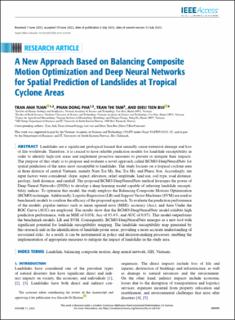| dc.identifier.citation | Tuan, T. A., Pha, P. D., Tam, T. T., & Bui, D. T. (2023). A New Approach Based on Balancing Composite Motion Optimization and Deep Neural Networks for Spatial Prediction of Landslides at Tropical Cyclone Areas. IEEE Access, 11, 69495-69511. | en_US |
| dc.description.abstract | Landslides are a significant geological hazard that annually cause extensive damage and loss of life worldwide. Therefore, it is crucial to have reliable prediction models for landslide susceptibility in order to identify high-risk areas and implement proactive measures to prevent or mitigate their impacts. The purpose of this study is to propose and evaluate a novel approach called BCM-DeepNeuralNets for spatial prediction of the areas most susceptible to landslides. The study focuses on a tropical cyclone area in three districts of central Vietnam, namely Nam Tra My, Bac Tra My, and Phuoc Son. Accordingly, ten input factors were considered: slope, aspect, elevation, relief amplitude, land use, soil type, road distance, geology, fault distance, and rainfall. The proposed BCM-DeepNeuralNets method leverages the power of Deep Neural Networks (DNNs) to develop a deep-learning model capable of inferring landslide susceptibility indices. To optimize this model, the study employs the Balancing Composite Motions (BCM) optimization technique. Additionally, Logistic Regression (LR) and Support Vector Machines (SVM) are used as benchmark models to confirm the efficacy of the proposed approach. To evaluate the prediction performance of the models, popular metrics such as mean squared error (MSE), accuracy (Acc), and Area Under the ROC Curve (AUC) are employed. The results show that the BCM-DeepNeuralNets model exhibits high prediction performance, with an MSE of 0.038, Acc of 93.4%, and AUC of 0.971. This model outperforms the benchmark models, LR and SVM. Consequently, BCM-DeepNeuralNets emerges as a new tool with significant potential for landslide susceptibility mapping. The landslide susceptibility map generated by this research aids in the identification of landslide-prone areas, providing a more accurate understanding of associated risks. As a result, it can be instrumental in policy and decision-making processes, enabling the implementation of appropriate measures to mitigate the impact of landslides in the study area. | en_US |

